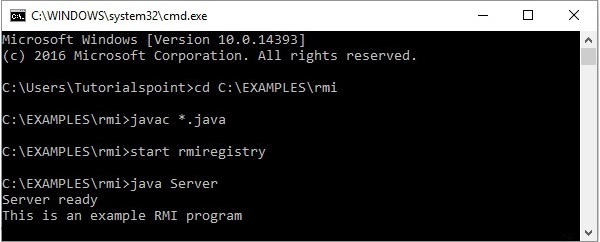- Java RMI-数据库应用程序
- Java RMI-数据库应用程序(1)
- 如何运行Java RMI 应用程序(1)
- 如何运行Java RMI 应用程序
- Java RMI-GUI应用程序
- Java RMI-GUI应用程序(1)
- Java RMI教程
- Java RMI教程(1)
- Java RMI-简介(1)
- Java RMI-简介
- 讨论Java RMI(1)
- 讨论Java RMI
- java rmi 示例客户端服务器 - Java (1)
- Java RMI-有用的资源
- Java RMI-有用的资源(1)
- java rmi 示例客户端服务器 - Java 代码示例
- Java中的远程方法调用RMI(1)
- Java RMI(远程方法调用)
- Java RMI(远程方法调用)(1)
- Java中的远程方法调用RMI
- Java RMI-快速指南(1)
- Java RMI-快速指南
- Java的.rmi.Naming类在Java中(1)
- Java的.rmi.Naming类在Java中
- Java的.rmi.RMISecurityManager类在Java中(1)
- Java中的Java .rmi.MarshalledObject 类
- Java中的Java .rmi.MarshalledObject 类(1)
- Java的.rmi.RMISecurityManager类在Java中
- Spring和RMI集成
📅 最后修改于: 2020-11-15 03:19:31 🧑 作者: Mango
要编写RMI Java应用程序,您必须遵循以下步骤-
- 定义远程接口
- 开发实现类(远程对象)
- 开发服务器程序
- 开发客户程序
- 编译应用
- 执行申请
定义远程接口
远程接口提供了特定远程对象的所有方法的描述。客户端与此远程接口进行通信。
创建一个远程接口-
-
创建一个接口,该接口扩展了属于该程序包的预定义接口Remote 。
-
声明客户端可以在此接口中调用的所有业务方法。
-
由于在远程调用期间可能会出现网络问题,因此可能会发生一个名为RemoteException的异常。丢它。
以下是远程接口的示例。在这里,我们定义了一个名称为Hello的接口,它具有一个名为printMsg()的方法。
import java.rmi.Remote;
import java.rmi.RemoteException;
// Creating Remote interface for our application
public interface Hello extends Remote {
void printMsg() throws RemoteException;
}
开发实现类(远程对象)
我们需要实现在先前步骤中创建的远程接口。 (我们可以单独编写一个实现类,也可以直接使服务器程序实现此接口。)
开发一个实现类-
- 实现上一步中创建的接口。
- 提供对远程接口的所有抽象方法的实现。
以下是一个实现类。在这里,我们创建了一个名为ImplExample的类,并实现了在上一步中创建的Hello接口,并为该方法提供了正文,该方法可以打印消息。
// Implementing the remote interface
public class ImplExample implements Hello {
// Implementing the interface method
public void printMsg() {
System.out.println("This is an example RMI program");
}
}
开发服务器程序
RMI服务器程序应实现远程接口或扩展实现类。在这里,我们应该创建一个远程对象并将其绑定到RMIregistry 。
开发服务器程序-
-
在要从中调用远程对象的位置创建一个客户端类。
-
通过实例化实现类创建一个远程对象,如下所示。
-
使用名为UnicastRemoteObject的类的方法exportObject()导出远程对象,该类属于包java.rmi.server 。
-
使用属于包java.rmi.registry的LocateRegistry类的getRegistry ()方法获取RMI注册表。
-
使用名为Registry的类的bind()方法将创建的远程对象绑定到注册表。向此方法传递代表绑定名称和导出对象的字符串作为参数。
以下是RMI服务器程序的示例。
import java.rmi.registry.Registry;
import java.rmi.registry.LocateRegistry;
import java.rmi.RemoteException;
import java.rmi.server.UnicastRemoteObject;
public class Server extends ImplExample {
public Server() {}
public static void main(String args[]) {
try {
// Instantiating the implementation class
ImplExample obj = new ImplExample();
// Exporting the object of implementation class
// (here we are exporting the remote object to the stub)
Hello stub = (Hello) UnicastRemoteObject.exportObject(obj, 0);
// Binding the remote object (stub) in the registry
Registry registry = LocateRegistry.getRegistry();
registry.bind("Hello", stub);
System.err.println("Server ready");
} catch (Exception e) {
System.err.println("Server exception: " + e.toString());
e.printStackTrace();
}
}
}
开发客户计划
在其中编写一个客户端程序,获取远程对象并使用该对象调用所需的方法。
开发客户端程序-
-
在您打算从中调用远程对象的位置创建一个客户端类。
-
使用属于包java.rmi.registry的LocateRegistry类的getRegistry ()方法获取RMI注册表。
-
使用属于包java.rmi.registry的Registry类的方法lookup()从注册表中获取对象。
对于此方法,您需要传递一个表示绑定名称的字符串值作为参数。这将返回您的远程对象。
-
lookup()返回一个远程类型的对象,将其向下转换为Hello类型。
-
最后,使用获取的远程对象调用所需的方法。
以下是RMI客户端程序的示例。
import java.rmi.registry.LocateRegistry;
import java.rmi.registry.Registry;
public class Client {
private Client() {}
public static void main(String[] args) {
try {
// Getting the registry
Registry registry = LocateRegistry.getRegistry(null);
// Looking up the registry for the remote object
Hello stub = (Hello) registry.lookup("Hello");
// Calling the remote method using the obtained object
stub.printMsg();
// System.out.println("Remote method invoked");
} catch (Exception e) {
System.err.println("Client exception: " + e.toString());
e.printStackTrace();
}
}
}
编译应用
编译应用程序-
- 编译远程接口。
- 编译实现类。
- 编译服务器程序。
- 编译客户端程序。
要么,
打开存储所有程序的文件夹,并编译所有Java文件,如下所示。
Javac *.java

执行申请
步骤1-使用以下命令启动rmi注册表。
start rmiregistry

如下所示,这将在另一个窗口上启动rmi注册表。

步骤2-运行服务器类文件,如下所示。
Java Server

步骤3-运行客户端类文件,如下所示。
java Client

验证-一旦启动客户端,您将在服务器中看到以下输出。
